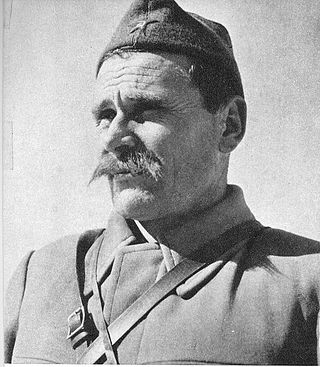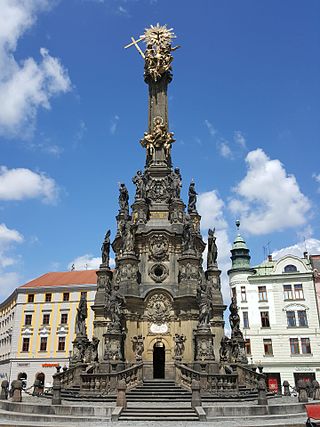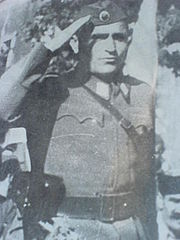Sava is a male personal name in South Slavic languages. Perhaps the most famous example is the Serbian medieval prince turned monk Saint Sava. In Croatia, Sava is found as a male name among the Serbs and also as a female name among the Croats, likewise in Bosnia and Herzegovina, a result of the tradition of naming female children after rivers – in this case, after the river Sava. It is also used in Romanian, where it is also a surname.

The Zlatibor District is one of eight administrative districts of Šumadija and Western Serbia. It is located in the western, mountainous part of Serbia. The district was named after the mountain region of Zlatibor.

Sava Kovačević was a Yugoslav Partisan divisional commander during World War II, and one of the heroes of the communist Partisan movement.

Operation Rösselsprung was a combined airborne and ground assault by the German XV Mountain Corps and collaborationist forces on the Supreme Headquarters of the Yugoslav Partisans in the Bosnian town of Drvar in the Independent State of Croatia during World War II. It was launched 25 May 1944, with the goal of capturing or killing Partisan leader Marshal Josip Broz Tito and destroying the headquarters, support facilities and co-located Allied military missions. It is associated with the Seventh Enemy Offensive in Yugoslav history, forming part of the Seven Enemy Offensives historiographical framework. The airborne assault itself is also known as the Raid on Drvar.

Marian columns are religious monuments depicting Virgin Mary on the top, often built in thanksgiving for the ending of a plague or for some other reason. The purpose of the Holy Trinity columns was usually simply to celebrate the church and the faith, though the plague motif could sometimes play its role in their erection as well. Erecting religious monuments in the form of a column surmounted by a figure or a Christian symbol was a gesture of public faith that flourished in the Catholic countries of Europe especially in the 17th and 18th centuries. Thus they became one of the most visible features of Baroque architecture. This usage also influenced some Eastern Orthodox Baroque architecture.

The Moscow Triumphal Gate is a Neoclassical triumphal arch in Saint Petersburg, Russia. The monument, built mainly in cast iron, was erected in 1834–1838 to commemorate the Russian victory in the Russo-Turkish War, 1828-1829.

Krnjača is an urban neighborhood of Belgrade, the capital of Serbia. It is located in Belgrade's municipality of Palilula.

Architectural sculpture is the use of sculptural techniques by an architect and/or sculptor in the design of a building, bridge, mausoleum or other such project. The sculpture is usually integrated with the structure, but freestanding works that are part of the original design are also considered to be architectural sculpture. The concept overlaps with, or is a subset of, monumental sculpture.
Kovačević, Kovačevič or Kovačovič, is a Slavic surname meaning "[black]smith's son". The surname is derived from Kovač, which means "[black]smith", and is the equivalent of English Smithson.

Grahovo is a village on the eastern shores of Lake Cerknica in the Municipality of Cerknica in the Inner Carniola region of Slovenia.

Vojin Bakić was a prominent Yugoslav sculptor.

Grahovo is a historical settlement in the Nikšić Municipality of northwestern Montenegro. It is located in the historical region of Grahovo.
Edo Kovačević was a Croatian artist, best known for his colourful landscapes and views of suburban Zagreb. He worked mainly in oils and pastels, using subtle colour harmonies and lively brush strokes to bring out the natural beauty of ordinary subjects. Kovačević also designed theatrical stage sets for the Croatian National Theatre, the Drama Theatre and the Puppet Theatre, for many years, taught art at the Zagreb School of Crafts, and organized art exhibitions and installations.

Belgrade Cooperative was a cooperative bank founded in 1882 to promote savings and support small enterprises, craftspeople and the poor of Belgrade. Member-shareholders have been paying membership in amount of one Serbian Dinar per week. That is the way for cooperative to become a public savings bank. Luka Ćelović was the first president of cooperative, also a first Serbian insurance group.

The Supreme Headquarters was created in June 1941 by the Central Committee of the Yugoslav Communist Party after the German-led Axis invasion of Yugoslavia of 6 April 1941. It was the main command and staff body of the Yugoslav Partisans, with Josip Broz Tito at its head.

Vlado Šegrt was a Yugoslav participant in the National Liberation Struggle and a socio-political worker in the Socialist Republics of Bosnia and Herzegovina and Yugoslavia. He was a reserve Major General and national hero of Yugoslavia. From September 1948 to March 1953 he was the President of the Presidium of the National Assembly of the People's Republic of Bosnia and Herzegovina.

The Royal Artillery Boer War Memorial is located on the south side of The Mall in Central London, close to the junction with Horse Guards Road at the northeast corner of St James's Park. Unveiled in 1910, it marks the deaths of the 1,083 soldiers of the Royal Artillery who died in the Second Boer War from 1899 to 1902 It has been a listed building since 1970.

Grahovo is a field and historical region in western Montenegro. The region's area roughly comprises 219 km2, west of Rudine, in the centre between Petrovići and Cuce, from the top of Orjen mountain to the west of the Ostrog Monastery.

The Grahovo Tribe or Grahovljani is a historical Serbo-Montenegrin tribe and region of Old Herzegovina in Montenegro. The Tribe was formed on Brotherhoods and other extinct tribes of Montenegro being one of the sixteen tribes of Herzegovina, along with the Riđani, Piva, Drobnjaci, Krivošije, Nikšići, Banjani, Mataruge, and others.
Kovačeviči are a brotherhood in Grahovo, Nikšić, from the Grahovo Tribe. The Kovačevići hail from several villages in Grahovo. They are by far the largest brotherhood of Grahovo.
















